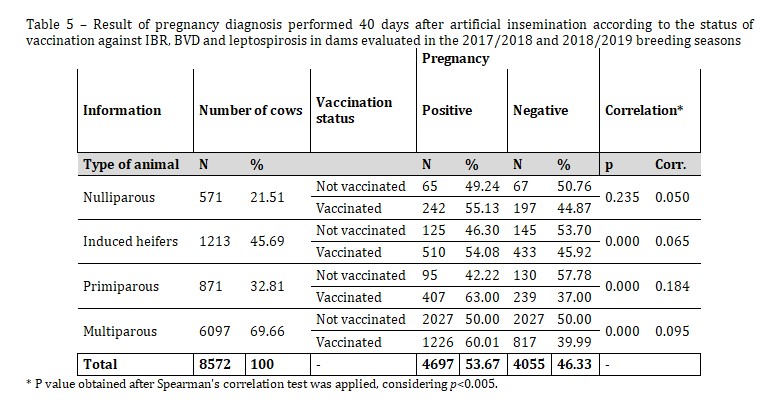Analysis of the efficiency of active immunization against IBR, BVD and leptospirosis in increasing pregnancy rate in FTAI protocols
DOI:
https://doi.org/10.21708/avb.2020.14.2.9115Abstract
Beef cattle farming is a highly representative activity for the GDP of Brazil, rendering the country an important producer of beef. For Brazil to maintain this prominent position, sanitary management actions must be carried out, such as the control of reproductive diseases. This study examines the effectiveness of vaccination against reproductive diseases in bovine females. Data from 8752 Zebu cows on the status of vaccination against reproductive diseases, body condition score (BCS) and the subsequent result of pregnancy diagnosis were evaluated. With regard to BCS, primiparous was the category that most demonstrated the effect of body condition on pregnancy rate, with BCS 3.5 cows having a 30% higher rate than the animals with BCS 2. In the group of nulliparous cows, those with BCS 3.5 had a pregnancy rate of 58% vs. 46% in BCS 3 cows. The induced nulliparae with BCS 3.5 had a 9% higher pregnancy rate than those with BCS 3. Multiparous cows also had a 9% higher rate when their BCS was 3.5 as compared with BCS 2. Among the evaluated dams, 46.5% were vaccinated against IBR, BVD and leptospirosis. Of these, the primiparae showed a 21% increase in conception as compared with the non-vaccinated group; multiparae, 10%; nulliparae, 5.9%; and induced nulliparae, 7.8%. In conclusion, BCS directly influences the reproductive efficiency of bovine females, and the use of vaccination against reproductive diseases can be recommended. However, this indication must be based on epidemiological and animal-performance data of each farm.
Downloads

Downloads
Pubblicato
Fascicolo
Sezione
Licenza
Autores que publicam na Acta Veterinaria Brasilica concordam com os seguintes termos: a) Autores mantém os direitos autorais e concedem à revista o direito de primeira publicação, com o trabalho simultaneamente licenciado sob a Licença Creative Commons Attribution que permite o compartilhamento do trabalho com reconhecimento da autoria e publicação inicial nesta revista. b) Autores têm autorização para assumir contratos adicionais separadamente, para distribuição não-exclusiva da versão do trabalho publicada nesta revista (ex.: publicar em repositório institucional ou como capítulo de livro), com reconhecimento de autoria e publicação inicial nesta revista. c) Autores têm permissão e são estimulados a publicar e distribuir seu trabalho online (ex.: em repositórios institucionais ou na sua página pessoal) a qualquer ponto antes ou durante o processo editorial, já que isso pode gerar alterações produtivas, bem como aumentar o impacto e a citação do trabalho publicado (Veja O Efeito do Acesso Livre).


 Esta obra está licenciada com uma Licença
Esta obra está licenciada com uma Licença 